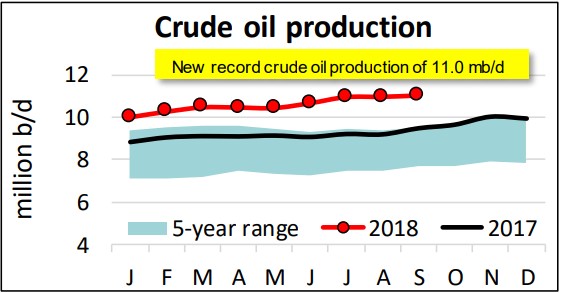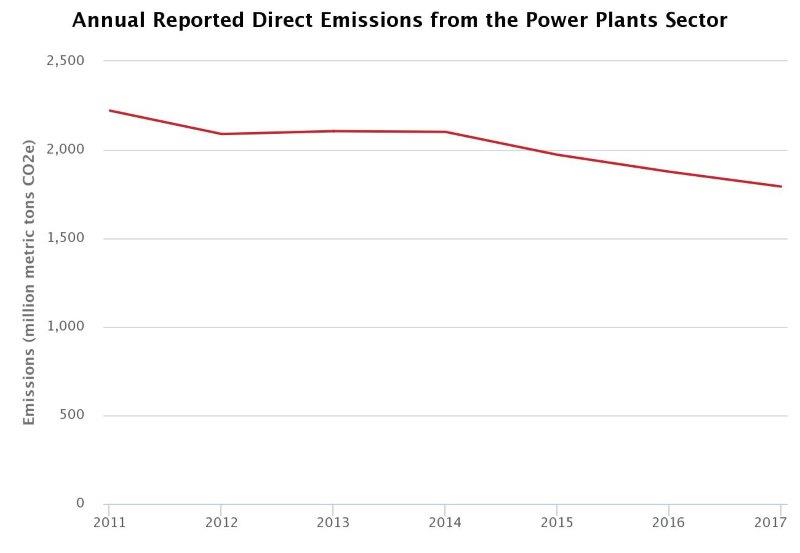Two stat lines capture the essence of modern natural gas and oil development:
First, the United States produced a record 11 million barrels of oil per day (mbd) in September, 2.2 mbd more than September 2017, according to API’s latest Monthly Statistical Report (MSR). It’s a remarkable output number, given where domestic production was less than two decades ago. A chart from the MSR shows the recent steady growth in U.S. crude oil production:

Thanks to technologies and innovations associated with developing energy from shale and other tight-rock formations and deep-water regions, the U.S. is the world’s leading producer natural gas and oil producer and refiner. Our domestic energy abundance has helped boost the economy and benefit consumers while making the nation stronger and more secure in the world. API Chief Economist Dean Foreman:
“The United States has continued to lead the world in oil production growth this year and that growth is helping to meet growing energy needs at home and abroad despite production losses by some OPEC nations. As a result, consumers have continued to enjoy affordable fuel prices that also are a key advantage for the U.S. economy.”
The U.S. is now producing crude oil at levels not seen since early in 1970, when 9.63 mbd on average were produced for the year.
Second point: Just as remarkable is the fact the United States’ world leadership in natural gas and oil production is accompanied by world leadership in cutting greenhouse gas emissions.
According to just-released EPA data, reported GHG emissions declined 2.7 percent since 2016 and, according to the U.S. Energy Information Administration, carbon dioxide emissions have reached 25-year lows. This is primarily due to increased use of clean natural gas as a fuel for generating electricity. EPA’s chart below shows that reported CO2 emissions from power plants have dropped 19.3 percent since 2011:

Howard Feldman, API senior director of regulatory and scientific affairs:
“The United States leads the world both in natural gas and oil production and in cutting GHG emissions – clean natural gas produced through advanced technologies like hydraulic fracturing is playing a significant role in driving carbon dioxide emissions to 25-year lows. Americans have the cleanest air in decades due in part to the increased use of natural gas to generate electricity, demonstrating that environmental protection and economic growth are not mutually exclusive.”
Feldman’s last point above is very important. The U.S. has shown that increased energy production, economic growth and significant environmental progress can occur together. The U.S. has not been forced to sacrifice energy and economic growth to achieve lower emissions.
There’s the increased use of natural gas that’s key, and also industry leadership in emissions-cutting technologies in operations and in products. Members of The Environmental Partnership are committed to further reducing methane emissions during natural gas and oil production. Feldman:
“The natural gas and oil industry has invested more than double the next highest industry sector in zero- and low-emissions technologies – since 2000 – to deliver the affordable and reliable energy we need while protecting human health and the environment and industry’s initiatives, highlighted by programs such as The Environmental Partnership, will further environmental progress.”
Again, these are the hallmarks of America’s modern natural gas and oil industry – producing more energy and doing it more efficiently through the use of advanced technologies, leading to lower emissions and cleaner air.
By Mark Green
Originally posted October 23, 2018
Energy Tomorrow is brought to you by the American Petroleum Institute (API), which is the only national trade association that represents all aspects of America’s oil and natural gas industry. Our more than 500 corporate members, from the largest major oil company to the smallest of independents, come from all segments of the industry. They are producers, refiners, suppliers, pipeline operators and marine transporters, as well as service and supply companies that support all segments of the industry.

